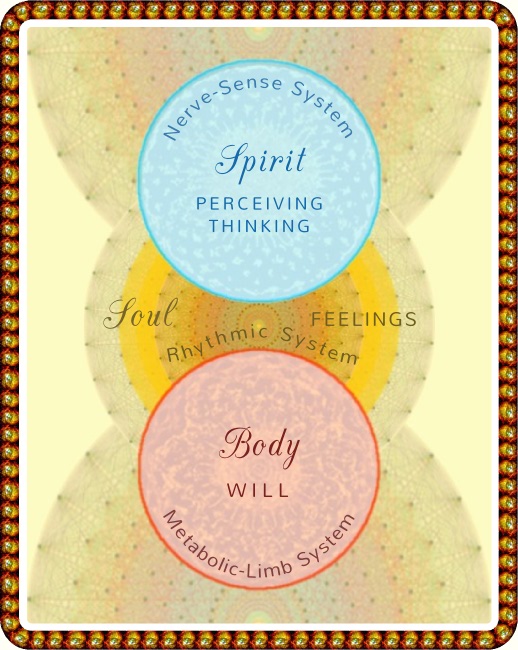THREE BODILY SYSTEMS AND THEIR ACTIVITIES
One of the most important questions the human being can ask is: What are
the relationships of my inner life of feelings, thinking and impulses of
Will [1] to my bodily constitution? Is everything centred in the brain – as
science interprets – or is there another explanation possible? Spiritual science
provides the following division of the human organism into three systems
with the corresponding soul-spiritual activities:
| System |
Nerve-Sense System |
Rhythmic System |
Metabolic-Limb System |
| Organs |
Brain, Spinal Cord, Nerves, Sense Organs |
Lungs, Heart, Blood Vessels |
Organs bellow the diaphragm (Stomach, Liver, Kidneys, etc), Muscles |
Physiological
Activities |
Communication from sense organs to the brain
[2] |
Breathing, Blood circulation |
Digestive processes, Metabolic processes,
Voluntary movement |
| Soul-Spiritual Activities |
Perceiving, Thinking |
Feeling, Inner Sensing [3]
|
Willing, Doing |
Thus we can distinguish in man “three members:
- the head;
- then the breast-organization embracing all that is
rhythmical, the breathing system and blood circulation;
- thirdly, the metabolic-limb system, which includes
nutrition, digestion and the distribution throughout the body of the
products of digestion, all of which engender movement. All this has to do
with the metabolic-limb system.” [4]
“The human being is made up of an organism of nerves and senses, a
rhythmic organism, and an organism of limbs and metabolism. These three
organisms work into one another. We may say that the organism of nerves and
senses has its principal activity in the head. But the whole human being
is, to a certain extent, functionally head. And the same may be said of the
other systems, that of the rhythmic organism and that of the trunk, limbs,
and metabolic activities. Now, when we take into account the threefold
being, we could present the human being schematically in somewhat the
following way. We have the nerve-sense organization, the rhythmic
organization, and the limb-metabolic organization.” [5]
“Now as human beings we are manifestly divided into the head system,
the chest system, and the digestive system with the limbs. But please
notice that this division into organised systems can very easily be
combated, because when men make systems today they want to have the
separate parts neatly arranged side by side. If we say that a man is
divided into a head system, chest system, and a system of the lower body
with the limbs, then people expect each of these systems to have a fixed
boundary. People want to draw lines where they divide, and that cannot
be done when dealing with realities. In the head we are principally
head, but the whole human being is head, only what is outside the head
is not principally head. For though the actual sense organs are in the
head, we have the sense of touch and the sense of warmth over the whole
body. Thus in that we feel warmth we are head all over. Only in the head
we are principally head, but we are secondarily head in the rest of the
body. Thus the parts are intermingled, and we are not so simply divided
as the pedants would have us be. The head extends everywhere, only it is
specially developed in the head proper. The same is true of the chest.
Chest is the real chest but only principally, for again the whole man is
chest. For the head is also to some extent chest as is the lower body
with the limbs. The different parts are intermingled. And it is just
the same in the lower body.” [6]
“On the one hand we have to do with a threefold nature of the soul
being: in forming mental images, in
feeling, and in Will impulses.
This threefold nature of the soul being, however, corresponds very
precisely with a threefolding of the physical-bodily being; a kind of
head system or nerve-sense system, a rhythmic system, and a
metabolic-limb system. I must stress particularly that this constitution
of the human organism must not be understood merely intellectually but
through inner perception. A person would be unable to comprehend how
matters actually stood if he remained with an external picture, if he
understood the head system as something that simply ends at the neck. What is important
here is that while the nerve-sense system is located primarily in the
head, it nevertheless extends over the entire remaining organism as
such. We may thus say that when we speak here with a spiritual-scientific
purpose about the nerve-sense system, it is the system of functions in
the human organism that is located essentially in
the head; nevertheless the head activity extends over the entire human
being so that in a certain sense the whole human being is head. The same
is true for the other systems.” [7]


